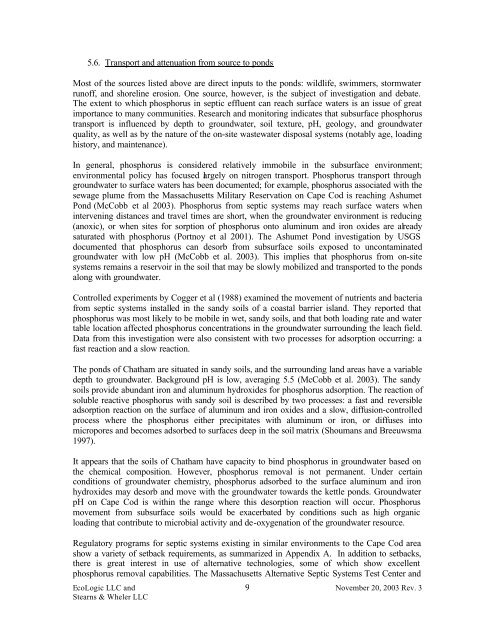Action Plan for the Town of Chatham Ponds
rev 3a report.pdf - Town to Chatham
rev 3a report.pdf - Town to Chatham
Create successful ePaper yourself
Turn your PDF publications into a flip-book with our unique Google optimized e-Paper software.
5.6. Transport and attenuation from source to ponds<br />
Most <strong>of</strong> <strong>the</strong> sources listed above are direct inputs to <strong>the</strong> ponds: wildlife, swimmers, stormwater<br />
run<strong>of</strong>f, and shoreline erosion. One source, however, is <strong>the</strong> subject <strong>of</strong> investigation and debate.<br />
The extent to which phosphorus in septic effluent can reach surface waters is an issue <strong>of</strong> great<br />
importance to many communities. Research and monitoring indicates that subsurface phosphorus<br />
transport is influenced by depth to groundwater, soil texture, pH, geology, and groundwater<br />
quality, as well as by <strong>the</strong> nature <strong>of</strong> <strong>the</strong> on-site wastewater disposal systems (notably age, loading<br />
history, and maintenance).<br />
In general, phosphorus is considered relatively immobile in <strong>the</strong> subsurface environment;<br />
environmental policy has focused largely on nitrogen transport. Phosphorus transport through<br />
groundwater to surface waters has been documented; <strong>for</strong> example, phosphorus associated with <strong>the</strong><br />
sewage plume from <strong>the</strong> Massachusetts Military Reservation on Cape Cod is reaching Ashumet<br />
Pond (McCobb et al 2003). Phosphorus from septic systems may reach surface waters when<br />
intervening distances and travel times are short, when <strong>the</strong> groundwater environment is reducing<br />
(anoxic), or when sites <strong>for</strong> sorption <strong>of</strong> phosphorus onto aluminum and iron oxides are already<br />
saturated with phosphorus (Portnoy et al 2001). The Ashumet Pond investigation by USGS<br />
documented that phosphorus can desorb from subsurface soils exposed to uncontaminated<br />
groundwater with low pH (McCobb et al. 2003). This implies that phosphorus from on-site<br />
systems remains a reservoir in <strong>the</strong> soil that may be slowly mobilized and transported to <strong>the</strong> ponds<br />
along with groundwater.<br />
Controlled experiments by Cogger et al (1988) examined <strong>the</strong> movement <strong>of</strong> nutrients and bacteria<br />
from septic systems installed in <strong>the</strong> sandy soils <strong>of</strong> a coastal barrier island. They reported that<br />
phosphorus was most likely to be mobile in wet, sandy soils, and that both loading rate and water<br />
table location affected phosphorus concentrations in <strong>the</strong> groundwater surrounding <strong>the</strong> leach field.<br />
Data from this investigation were also consistent with two processes <strong>for</strong> adsorption occurring: a<br />
fast reaction and a slow reaction.<br />
The ponds <strong>of</strong> <strong>Chatham</strong> are situated in sandy soils, and <strong>the</strong> surrounding land areas have a variable<br />
depth to groundwater. Background pH is low, averaging 5.5 (McCobb et al. 2003). The sandy<br />
soils provide abundant iron and aluminum hydroxides <strong>for</strong> phosphorus adsorption. The reaction <strong>of</strong><br />
soluble reactive phosphorus with sandy soil is described by two processes: a fast and reversible<br />
adsorption reaction on <strong>the</strong> surface <strong>of</strong> aluminum and iron oxides and a slow, diffusion-controlled<br />
process where <strong>the</strong> phosphorus ei<strong>the</strong>r precipitates with aluminum or iron, or diffuses into<br />
micropores and becomes adsorbed to surfaces deep in <strong>the</strong> soil matrix (Shoumans and Breeuwsma<br />
1997).<br />
It appears that <strong>the</strong> soils <strong>of</strong> <strong>Chatham</strong> have capacity to bind phosphorus in groundwater based on<br />
<strong>the</strong> chemical composition. However, phosphorus removal is not permanent. Under certain<br />
conditions <strong>of</strong> groundwater chemistry, phosphorus adsorbed to <strong>the</strong> surface aluminum and iron<br />
hydroxides may desorb and move with <strong>the</strong> groundwater towards <strong>the</strong> kettle ponds. Groundwater<br />
pH on Cape Cod is within <strong>the</strong> range where this desorption reaction will occur. Phosphorus<br />
movement from subsurface soils would be exacerbated by conditions such as high organic<br />
loading that contribute to microbial activity and de-oxygenation <strong>of</strong> <strong>the</strong> groundwater resource.<br />
Regulatory programs <strong>for</strong> septic systems existing in similar environments to <strong>the</strong> Cape Cod area<br />
show a variety <strong>of</strong> setback requirements, as summarized in Appendix A. In addition to setbacks,<br />
<strong>the</strong>re is great interest in use <strong>of</strong> alternative technologies, some <strong>of</strong> which show excellent<br />
phosphorus removal capabilities. The Massachusetts Alternative Septic Systems Test Center and<br />
EcoLogic LLC and 9<br />
November 20, 2003 Rev. 3<br />
Stearns & Wheler LLC
















